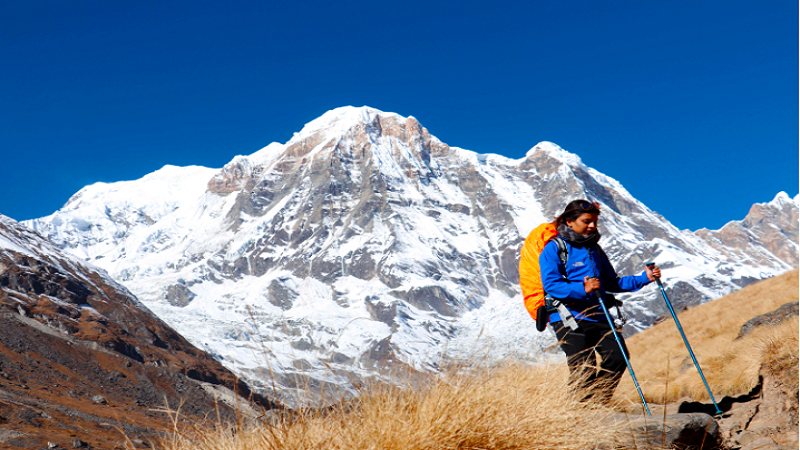Annapurna Base Camp Trek A Complete Adventure Guide
The Annapurna Base Camp Trek A Complete Adventure Guide is an exhilarating journey that offers a deep dive into the heart of the Himalayas, providing an unforgettable adventure for trekkers. Nestled in Nepal, this trek takes you to the base of Annapurna I, the tenth highest peak in the world, and immerses you in a landscape of breathtaking beauty and diverse cultures.
Starting from the vibrant city of Pokhara, the trek begins with a scenic drive or flight to Nayapul. From there, trekkers follow a well-trodden path that weaves through lush terraced fields, quaint villages, and dense forests. The route gradually ascends through the Modi Khola Valley, passing through picturesque hamlets like Ghorepani and Poon Hill. The journey up to Poon Hill, though not the final destination, is noteworthy for its spectacular sunrise views over the Annapurna and Dhaulagiri ranges, offering an early glimpse of the grandeur that lies ahead.
As the trek progresses, the landscape transforms from subtropical forests to alpine meadows and eventually to the rugged terrain near the base camp. Villages like Tadapani and Chhomrong offer unique cultural interactions and stunning mountain views. The ascent through these villages provides an opportunity to experience the traditional lives of the Gurung and Magar communities, who have lived in harmony with the mountains for generations.
Upon reaching the Annapurna Base Camp, located at an altitude of 4,130 meters (13,550 feet), trekkers are greeted by an awe-inspiring panorama of towering peaks, including Annapurna I, Machapuchare (the Fish Tail), and Hiunchuli. The base camp is surrounded by a natural amphitheater of snow-capped giants, creating a dramatic and serene setting. The sense of achievement at the base camp is profound, offering a moment of reflection and admiration of the raw power and beauty of the Himalayas.
The trek also provides a chance to experience diverse ecosystems and wildlife. From the lush forests rich with rhododendrons and oak trees to the high-altitude landscapes dotted with yak herders and grazing animals, the journey is a testament to nature’s variety. The changing environment is as much a part of the trek as the physical challenge, enhancing the adventure with each passing day.
Health and safety are critical considerations on this trek. Adequate preparation, including proper acclimatization, is essential to tackle the high altitudes and avoid altitude sickness. It’s also important to pack appropriate gear, including layers for varying weather conditions, sturdy trekking boots, and a reliable sleeping bag suitable for cold temperatures.
Overall, the Annapurna Base Camp Trek offers a complete adventure, combining physical challenge, cultural exploration, and unparalleled natural beauty. It is a trek that promises not only the thrill of reaching one of the world’s most iconic base camps but also a deep connection with the Himalayan landscape and the people who call it home.
Introduction
The 10 Days Annapurna Base Camp Trek A Complete Adventure Guide is one of Nepal’s most iconic and rewarding trekking routes, offering an immersive experience into the heart of the Himalayas. This trek takes adventurers through a diverse range of landscapes, from lush subtropical forests to high-altitude alpine meadows, all culminating at the base camp of Annapurna I, one of the world’s tallest peaks. The trek is renowned for its stunning panoramic views, rich cultural interactions, and the sense of accomplishment that comes with reaching the base camp, situated at 4,130 meters (13,550 feet). The journey provides a unique opportunity to explore the Annapurna Sanctuary, a natural amphitheater surrounded by towering snow-capped peaks. With its blend of challenging terrain and breathtaking scenery, the Annapurna Base Camp Trek is a quintessential adventure for trekking enthusiasts seeking both natural beauty and cultural experiences.
Overview of the Annapurna Base Camp Trek
The Annapurna Base Camp Trek is a captivating journey that begins from the picturesque city of Pokhara. Trekkers typically start with a drive or flight to Nayapul, from where the trek officially begins. The route follows the Modi Khola Valley, passing through charming villages like Tikhedhunga and Ghorepani, and eventually ascending to the base camp. The trek covers approximately 115 kilometers (71 miles) round-trip and usually takes 7 to 12 days to complete, depending on the pace and itinerary. Along the way, trekkers traverse through diverse landscapes, including terraced fields, lush forests, and high-altitude terrain. The journey offers a chance to experience the traditional lifestyles of local Gurung and Magar communities, with opportunities to explore their unique cultures and customs. Reaching Annapurna Base Camp, surrounded by a dramatic backdrop of towering peaks, provides a profound sense of accomplishment and awe.
Trek Highlights
The Annapurna Base Camp Trek A Complete Adventure Guide is full of unforgettable highlights. One of the most memorable is the ascent to Poon Hill, where trekkers witness a breathtaking sunrise over the Annapurna and Dhaulagiri ranges. This early morning hike offers a stunning preview of the peaks that will dominate the later stages of the trek.
Along the way, trekkers visit culturally rich villages like Ghandruk and Chhomrong. Here, they can interact with local communities and learn about traditional ways of life.
Another highlight is the approach to Annapurna Base Camp, a dramatic natural amphitheater surrounded by towering peaks such as Annapurna I, Machapuchare, and Hiunchuli. The trek’s diverse ecosystems, from dense rhododendron forests to alpine meadows, add to its charm.
These elements weave together to create a truly memorable adventure.
Best Time to Trek
Choosing the best time to trek to Annapurna Base Camp Trek A Complete Adventure Guide is crucial for a successful and enjoyable experience. The optimal seasons are pre-monsoon (March to May) and post-monsoon (September to November). The pre-monsoon season features blooming rhododendrons and lush landscapes, offering vibrant scenery. The post-monsoon period provides crisp air and excellent visibility, ideal for capturing stunning mountain views. Winter (December to February) presents colder temperatures and potential snowfall, which can make trekking conditions more challenging and potentially hazardous, especially at higher altitudes. The monsoon season (June to August) brings heavy rains, increasing the risk of landslides, muddy trails, and reduced visibility. Therefore, trekking during the recommended seasons maximizes comfort and safety, allowing trekkers to fully appreciate the stunning landscapes and clear views of the Annapurna range.
Permits and Regulations
Embarking on the Short Annapurna Base Camp Trek requires obtaining several permits and adhering to local regulations to ensure a smooth and lawful trekking experience. Trekkers must secure the Annapurna Conservation Area Permit (ACAP) and the Trekkers’ Information Management System (TIMS) card. The ACAP is required for entry into the Annapurna Conservation Area. It helps fund conservation efforts and local development. You can obtain these permits through trekking agencies, local tourism offices, or online. It’s important to carry these documents during the trek, as they may be checked at various points. Additionally, follow local guidelines, respect cultural traditions, and practice sustainability to protect the beautiful landscapes and rich heritage of the Annapurna region. Ensuring all necessary permits are in place and understanding the regulations contribute to a responsible and enjoyable trekking experience.
Fitness and Preparation
Embarking on the Annapurna Base Camp Trek A Complete Adventure Guide requires a combination of physical fitness and thorough preparation to ensure a successful and enjoyable journey. Given the trek’s diverse terrain and varying altitudes, it is essential to engage in a fitness regimen that enhances endurance, strength, and stamina. Prior to the trek, focus on cardiovascular exercises like running, cycling, or swimming to build stamina. Additionally, incorporate strength training for your legs and core to handle the uphill climbs and descents. Long hikes with a loaded backpack can simulate the conditions you’ll face on the trek, preparing your body for the physical demands of the journey.
Flexibility exercises, such as yoga or stretching, can significantly help prevent injuries and improve overall mobility. Moreover, mental preparation is equally important; thus, familiarize yourself with the trek’s challenges and consider practicing mindfulness techniques to manage stress effectively. As a result, you will not only enhance your trekking experience but also contribute to a safer and more enjoyable adventure.
By incorporating more transition words, the flow of the text becomes smoother and enhances clarity.
Gear and Packing List
Packing for the Annapurna Base Camp Trek A Complete Adventure Guide requires careful consideration of the region’s variable weather and terrain. Essential gear includes sturdy, well-fitted hiking boots that provide good ankle support and traction, as the trail can be rugged and uneven. A layered clothing system is crucial: start with moisture-wicking base layers, then add insulating mid-layers like fleece or down jackets. Finally, wear a waterproof outer layer, such as a rain jacket and pants, to ensure comfort in changing weather.
Additionally, pack a sturdy backpack with a rain cover, a reliable sleeping bag for chilly nights, and trekking poles for stability. Include a headlamp or flashlight with extra batteries, a wide-brimmed hat, gloves, and sunglasses for sun protection. Personal items like a water purification system, a first aid kit, and high-energy snacks should also be included. Having the appropriate gear will enhance your comfort and safety throughout the trek, allowing you to fully enjoy the adventure.
Day-by-Day Itinerary
The Annapurna Base Camp Trek typically unfolds over a 7 to 12-day itinerary, depending on the pace and acclimatization needs. The journey begins with a drive or flight from Pokhara to Nayapul. From there, the first day’s trek leads to Tikhedhunga or Ulleri, passing through lush forests and terraced fields.
On the second day, trekkers climb to Ghorepani, which is renowned for its stunning sunrise views from Poon Hill. The trek continues to Tadapani and Chhomrong, offering opportunities to explore traditional villages and breathtaking landscapes.
From Chhomrong, the ascent takes trekkers through bamboo and rhododendron forests to Dobhan, then to Machapuchare Base Camp. Here, the views of the towering peaks become even more dramatic. The final push to Annapurna Base Camp takes trekkers through a natural amphitheater surrounded by majestic peaks.
After spending time at the base camp, the return journey retraces the route. This often includes stops in different villages to experience varied perspectives of the trek. Overall, the itinerary provides a balanced mix of trekking days and acclimatization periods, ensuring a comprehensive and rewarding adventure.
Accommodation and Meals
Accommodation on the Annapurna Base Camp Trek primarily consists of teahouses or lodges that offer basic but comfortable facilities. These lodges are typically family-run and provide essential amenities like beds with clean linens and communal dining areas. In higher altitudes, accommodations become more basic, with fewer facilities, but they still offer a cozy place to rest after a day of trekking. Meals are provided at the lodges, featuring a range of local and international dishes. Commonly available foods include dal bhat (a traditional Nepali meal of rice and lentil soup), noodles, soups, and various vegetable dishes. Trekkers can also enjoy tea, coffee, and snacks. While the food is nutritious and adequate for the trek, it is important to choose well-cooked meals to avoid digestive issues. The dining experience in the teahouses offers an opportunity to interact with fellow trekkers and enjoy the hospitality of the local communities.
Altitude Sickness and Health Tips
Altitude sickness is a common concern on the Annapurna Base Camp Trek due to the trek’s high elevations. Symptoms can range from mild, such as headaches and nausea, to severe, including dizziness and shortness of breath. To mitigate the risk of altitude sickness, gradual acclimatization is essential. Ascend slowly, allowing your body to adjust to the decreasing oxygen levels, and include acclimatization days in your itinerary.. Pay attention to your body’s signals and be prepared to descend if severe symptoms occur. It’s also wise to consult a healthcare professional before the trek, particularly if you have pre-existing health conditions. Carrying medications like Diamox, which can help with acclimatization, and having a well-stocked first aid kit can provide additional support. Prioritizing health and safety throughout the trek ensures a more enjoyable and successful adventure.
Safety and Emergency Procedures
Safety is paramount when trekking to Annapurna Base Camp due to the rugged terrain and high altitudes. Familiarize yourself with essential safety procedures and emergency protocols before setting out. Ensure you have proper travel insurance that covers high-altitude trekking and emergency evacuation.
In the event of a medical emergency, helicopter evacuation may be the quickest option. This can be arranged through local agencies or your insurance provider. Learn basic first aid skills and carry a well-equipped first aid kit. Include items such as altitude sickness medication, blister treatment, and general pain relief.
Keep emergency contact numbers handy, including those for local trekking agencies and medical facilities. Communicate your trek itinerary and expected return date to someone reliable. Understanding how to recognize and respond to signs of altitude sickness is critical. Know when to descend if symptoms worsen.
By prioritizing safety and preparing for emergencies, you can navigate the trek with greater confidence and peace of mind.
Local Culture and Etiquette
The Annapurna Base Camp Trek passes through several traditional villages where respect for local culture and customs is important. The region is predominantly inhabited by Gurung and Magar communities, each with their own rich traditions and practices. When you meet locals, greet them warmly. Additionally, it is important to always ask for permission before taking photos, especially in religious or private areas. Furthermore, dress modestly, particularly when visiting temples or monasteries. Finally, don’t forget to remove your shoes before entering these sacred sites. By following these guidelines, you will show respect for the local culture. It’s customary to say “Namaste” and use your right hand to give or receive items. Honor local customs, including how food is prepared and enjoyed. Be aware of the practices surrounding religious sites. Embracing these cultural norms enriches your trekking experience. It also encourages positive connections with the communities you encounter along the way.
Flora and Fauna
The Annapurna Base Camp Trek showcases diverse flora and fauna. It reflects the varied ecosystems along the route. At lower elevations, trekkers wander through vibrant forests filled with rhododendron, oak, and pine trees. As they ascend, the landscape shifts to stunning alpine meadows. This region is home to wildlife, including the elusive snow leopard, red panda, and various species of pheasants and deer.In the lower altitudes, keep an eye out for the colorful Himalayan tahr and the elusive musk deer. The trek also presents opportunities to see rare and medicinal plants used in traditional Nepali medicine. As you ascend, the flora becomes sparser, giving way to hardy alpine species adapted to the harsh conditions. Respect the natural environment by not disturbing wildlife or picking plants, and follow established trails to minimize impact.
Cost and Budgeting
Budgeting for the Annapurna Base Camp Trek involves several considerations, including permits, accommodation, food, and additional expenses. The trek typically costs between $1,000 and $2,500. This varies based on the trekking agency, trek length, and additional services. Key expenses include the Annapurna Conservation Area Permit (ACAP) and the Trekkers’ Information Management System (TIMS) card, which together cost about $50 to $60. Accommodation and meals in teahouses are quite affordable. Lodging is usually between $10 and $20 per night, while meals range from $5 to $15 each. Other costs may include tips for guides and porters, personal gear, and optional activities like side treks or cultural tours. It’s smart to carry extra cash for unexpected expenses, as credit card facilities are limited in remote areas. Planning and budgeting carefully ensure that you can enjoy the trek without financial stress.
Conclusion and Final Tips
The Annapurna Base Camp Trek offers a magnificent adventure through stunning mountain ranges. To make your journey memorable and successful, preparation is crucial. Start by assessing your fitness and committing to a training plan that prepares you for the physical challenges ahead.
Equip yourself with essential gear and a well-organized packing list. Familiarize yourself with the trek’s itinerary and local conditions.
Safety should be a priority. Ensure you understand emergency procedures and carry the necessary permits. Show respect for local culture, and take time to enjoy the diverse flora and fauna along the trail.
Budget wisely and prepare for unexpected costs. Stay flexible and open-minded, as the trek is about both personal growth and reaching base camp.
By following these tips, you’ll maximize your enjoyment and create lasting memories on this remarkable journey.
If you need more news feel free to visit my website: Lyncconf







